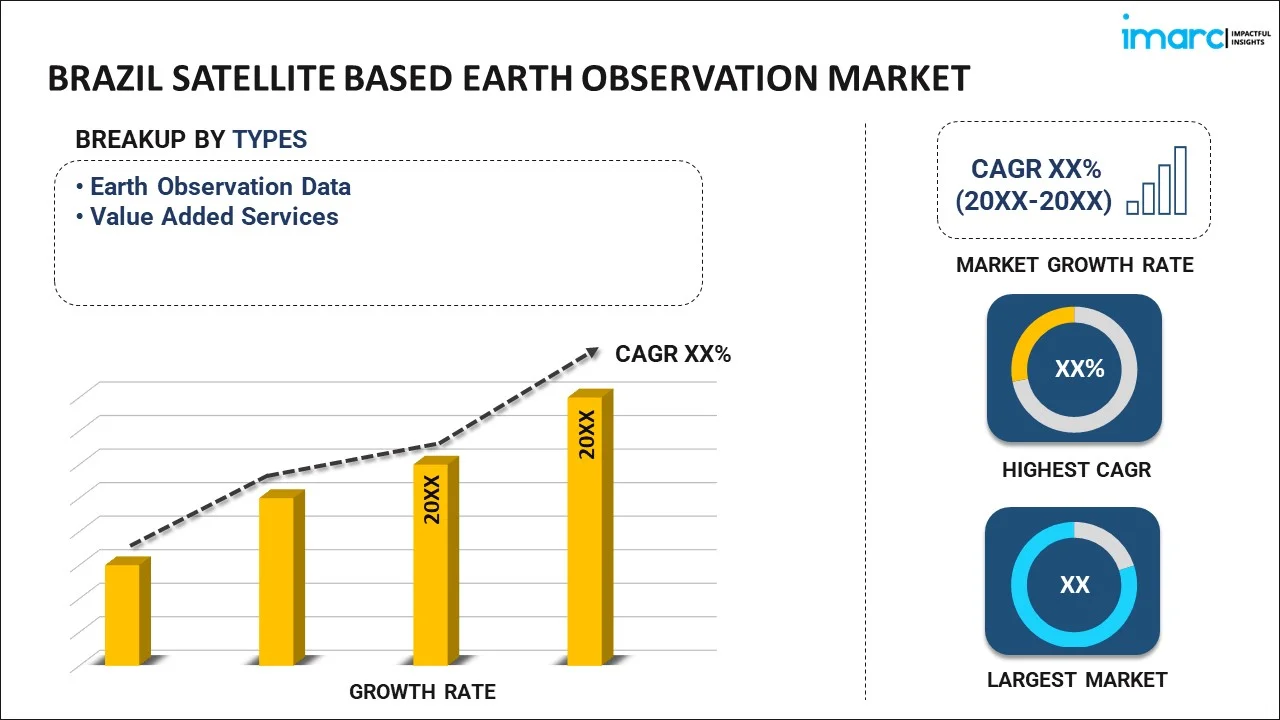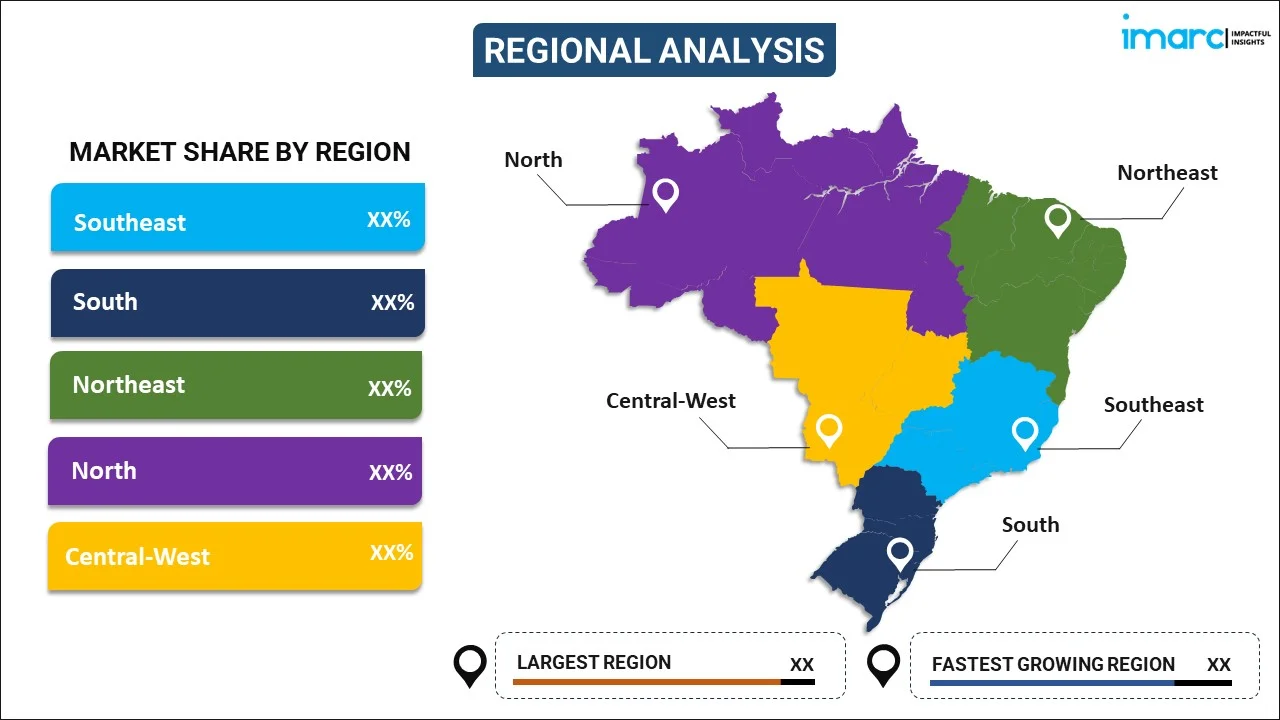
Brazil Satellite Based Earth Observation Market Report by Type (Earth Observation Data, Value Added Services), Satellite Orbit (Low Earth Orbit, Medium Earth Orbit, Geostationary Orbit), End User (Urban Development and Cultural Heritage, Agriculture, Climate Services, Energy and Raw Materials, Infrastructure, and Others), and Region 2025-2033
Market Overview:
Brazil satellite based earth observation market size reached USD 76 Million in 2024. Looking forward, IMARC Group expects the market to reach USD 142 Million by 2033, exhibiting a growth rate (CAGR) of 7.2% during 2025-2033. The rising interest in Brazil's space program, growing environmental concerns, the development and launch of indigenous satellites, increasing use of satellite data for scientific research and extensive scientific research efforts, represent some of the key factors driving the market.
|
Report Attribute
|
Key Statistics
|
|---|---|
|
Base Year
|
2024
|
|
Forecast Years
|
2025-2033
|
|
Historical Years
|
2019-2024
|
|
Market Size in 2024
|
USD 76 Million |
|
Market Forecast in 2033
|
USD 142 Million |
| Market Growth Rate 2025-2033 | 7.2% |
Satellite-based Earth observation, often referred to as remote sensing, is a powerful technology that involves the use of orbiting satellites equipped with sensors and cameras to collect data and imagery of the Earth's surface, atmosphere, and oceans. These satellites capture a wide range of information, including high-resolution images, temperature measurements, and spectral data, which are then used for various applications across different fields. This technology provides a valuable tool for monitoring and understanding our planet, and it has diverse applications in agriculture, environmental monitoring, disaster management, urban planning, weather forecasting, and scientific research. Satellite-based Earth observation plays a crucial role in tracking climate change, studying natural disasters, assessing land use and land cover changes, and supporting resource management. It offers a global perspective, allowing us to observe and analyze Earth's dynamic processes and changes over time, providing valuable insights for informed decision-making in both public and private sectors. The data and imagery collected from these satellites contribute to a more sustainable and interconnected world by enabling scientists, policymakers, and businesses to make informed choices and address pressing global challenges.
Brazil Satellite Based Earth Observation Market Trends:
Brazil's ambitious space program, which includes the development and launch of indigenous satellites, has greatly bolstered the domestic Earth observation capabilities, fostering the market growth. Besides this, the growing environmental concerns related to deforestation in the Amazon rainforest, forest fires, and land use changes have led to an increased demand for satellite-based monitoring and data to support conservation efforts and sustainable land management, creating a favorable outlook for market expansion. Moreover, Brazil's vast and diverse agricultural industry relies heavily on accurate Earth observation data for crop monitoring, yield estimation, and weather forecasting, which is contributing to the market's growth. Concurrently, the increasing use of satellite-based Earth observation across the thriving insurance and risk management sector to assess natural disasters, such as floods and droughts, and their impacts on agricultural and urban areas is bolstering the market growth. In addition to this, Brazil's commitment to urban planning and infrastructure development has driven the need for satellite data for city management, land-use planning, and disaster risk reduction, providing an impetus to the market growth. Furthermore, the burgeoning expansion of Brazil's energy sector, particularly hydropower generation, which requires Earth observation data for water resource management, reservoir monitoring, and environmental impact assessments, is acting as another significant growth-inducing factor. Apart from this, the growing use of satellite data for scientific research, including climate studies and biodiversity monitoring, has spurred market growth and collaboration between the academic and research communities.
Brazil Satellite Based Earth Observation Market Segmentation:
IMARC Group provides an analysis of the key trends in each segment of the market, along with forecasts at the country level for 2025-2033. Our report has categorized the market based on type, satellite orbit, and end user.
Type Insights:

- Earth Observation Data
- Value Added Services
The report has provided a detailed breakup and analysis of the market based on the type. This includes earth observation data and value added services.
Satellite Orbit Insights:
- Low Earth Orbit
- Medium Earth Orbit
- Geostationary Orbit
A detailed breakup and analysis of the market based on the satellite orbit have also been provided in the report. This includes low earth orbit, medium earth orbit, and geostationary orbit.
End User Insights:
- Urban Development and Cultural Heritage
- Agriculture
- Climate Services
- Energy and Raw Materials
- Infrastructure
- Others
The report has provided a detailed breakup and analysis of the market based on the end user. This includes urban development and cultural heritage, agriculture, climate services, energy and raw materials, infrastructure, and others.
Regional Insights:

- Southeast
- South
- Northeast
- North
- Central-West
The report has also provided a comprehensive analysis of all the major regional markets, which include Southeast, South, Northeast, North, and Central-West.
Competitive Landscape:
The market research report has also provided a comprehensive analysis of the competitive landscape in the market. Competitive analysis such as market structure, key player positioning, top winning strategies, competitive dashboard, and company evaluation quadrant has been covered in the report. Also, detailed profiles of all major companies have been provided.
Brazil Satellite Based Earth Observation Market Report Coverage:
| Report Features | Details |
|---|---|
| Base Year of the Analysis | 2024 |
| Historical Period | 2019-2024 |
| Forecast Period | 2025-2033 |
| Units | Million USD |
| Scope of the Report | Exploration of Historical Trends and Market Outlook, Industry Catalysts and Challenges, Segment-Wise Historical and Future Market Assessment:
|
| Types Covered | Earth Observation Data, Value Added Services |
| Satellite Orbits Covered | Low Earth Orbit, Medium Earth Orbit, Geostationary Orbit |
| End Users Covered | Urban Development and Cultural Heritage, Agriculture, Climate Services, Energy and Raw Materials, Infrastructure, Others |
| Regions Covered | Southeast, South, Northeast, North, Central-West |
| Customization Scope | 10% Free Customization |
| Post-Sale Analyst Support | 10-12 Weeks |
| Delivery Format | PDF and Excel through Email (We can also provide the editable version of the report in PPT/Word format on special request) |
Key Questions Answered in This Report:
- How has the Brazil satellite based earth observation market performed so far and how will it perform in the coming years?
- What has been the impact of COVID-19 on the Brazil satellite based earth observation market?
- What is the breakup of the Brazil satellite based earth observation market on the basis of type?
- What is the breakup of the Brazil satellite based earth observation market on the basis of satellite orbit?
- What is the breakup of the Brazil satellite based earth observation market on the basis of end user?
- What are the various stages in the value chain of the Brazil satellite based earth observation market?
- What are the key driving factors and challenges in the Brazil satellite based earth observation?
- What is the structure of the Brazil satellite based earth observation market and who are the key players?
- What is the degree of competition in the Brazil satellite based earth observation market?
Key Benefits for Stakeholders:
- IMARC’s industry report offers a comprehensive quantitative analysis of various market segments, historical and current market trends, market forecasts, and dynamics of the Brazil satellite based earth observation market from 2019-2033.
- The research report provides the latest information on the market drivers, challenges, and opportunities in the Brazil satellite based earth observation market.
- Porter's five forces analysis assist stakeholders in assessing the impact of new entrants, competitive rivalry, supplier power, buyer power, and the threat of substitution. It helps stakeholders to analyze the level of competition within the Brazil satellite based earth observation industry and its attractiveness.
- Competitive landscape allows stakeholders to understand their competitive environment and provides an insight into the current positions of key players in the market.
Need more help?
- Speak to our experienced analysts for insights on the current market scenarios.
- Include additional segments and countries to customize the report as per your requirement.
- Gain an unparalleled competitive advantage in your domain by understanding how to utilize the report and positively impacting your operations and revenue.
- For further assistance, please connect with our analysts.
 Inquire Before Buying
Inquire Before Buying
 Speak to an Analyst
Speak to an Analyst
 Request Brochure
Request Brochure
 Request Customization
Request Customization




.webp)




.webp)












